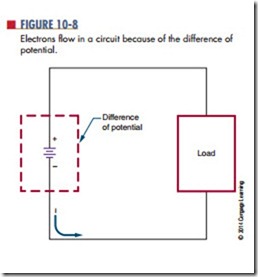Voltage
When there is an excess of electrons (negative charge) at one end of a conductor and a deficiency of electrons (positive charge) at the opposite end, a current flows between the two ends as long as this condition persists. The source that creates this excess of electrons at one end and the deficiency at the other end represents the potential, or the ability of the source to perform electrical work.
The actual work accomplished in a circuit is a result of the difference of potential available at the two ends of a conductor. This difference of potential causes electrons to move or flow in a circuit (Figure 10-8) and is referred to as electromotive force (emf) or
voltage. Voltage is the force that moves the electrons in the circuit. Think of voltage as the pressure or pump that moves the electrons.
The symbol e is used in electronics to represent voltage. The unit for measuring voltage is the volt (V), named for Count Alessandro Volta (1745–1827), inventor of the first cell to produce electricity.
Questions
1. What force moves electrons in a circuit?
2. What is the term that represents the potential between the two ends of a conductor?
3. What symbol is used to represent voltage?
4. What symbol is used to represent the unit volt?
5. Who invented the first cell to produce electricity?
